When you think about wireless music, one name comes to mind. Sonos. And unless you’re a diehard analog music fan who shuns anything digital, you’ve likely encountered the Sonos brand. It effectively pioneered and normalized the idea of multi-room, digital wireless audio, and it’s still the gold standard to beat.
Curious about what exactly Sonos does, and how it works in the same world that already includes Apple, Spotify, and even your old Technics turntable? Is Sonos right for you? Let’s dig into it.
What is Sonos?
Sonos is an audio equipment company that specializes in wireless, multi-room systems. It started in 2002 with software and hardware that let people play their personal digital music collections wirelessly on existing audio gear, and then rapidly expanded into designing and selling all-in-one wireless speakers. Those speakers now include portable models that cost as little as $120 to full Dolby Atmos-capable home theater soundbars that cost almost $900. It has partnered with Ikea on a range of affordable home-décor speakers under the Symfonisk brand, and you’ll even find its speakers in some recent Audis.
All of Sonos’ hardware products, as well as those Ikea Symfonisk speakers, are controlled by the Sonos software, creating a full audio ecosystem. The biggest benefits that come along with this ecosystem are ease-of-use, simplicity, and flexibility. You can configure up to 32 different Sonos components in one household, each in its own room, or grouped together in any combination you want. Better yet, each of those components can play a different song, or they can all play the same song in perfect sync, or you can create smaller groupings, each with its own soundtrack. It’s all managed through a simple-to-understand app on your phone, tablet, or computer.
How much does Sonos cost?

The first step into the Sonos ecosystem can be as low as $120 — the cost of its most affordable speaker, the Ikea-branded Symfonisk Bookshelf Speaker. From there, the sky’s the limit.
You’ll find speakers and components for a variety of room sizes and listening activities, including portable speakers, ceiling-mounted architectural speakers, outdoor speakers, and soundbars, including the $899 Dolby Atmos-capable Sonos Arc which can be used on its own or with additional Sonos speakers for a full home theater package. The Sonos app is free to download.
Does Sonos make smart speakers?
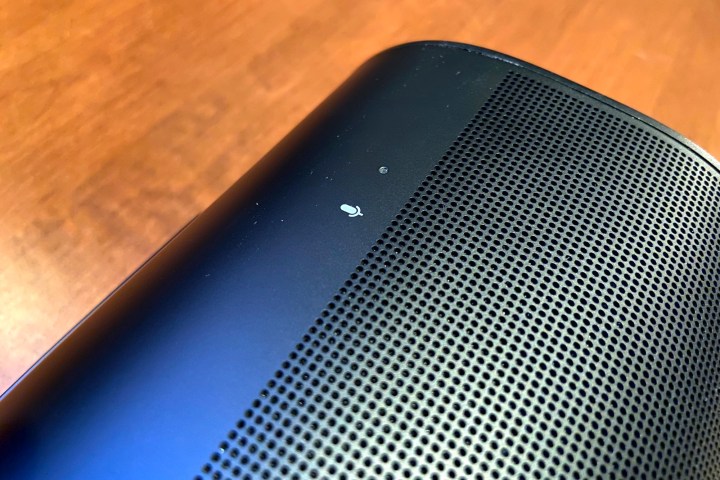
It does. As you can see in the list above, the Sonos Roam, Era 100, Era 300, Move, Beam, and Arc are all voice-enabled. However they don’t all offer the same voice assistant choices at the moment,
The Sonos Roam, Move, Beam, and Arc are compatible with Alexa, Google Assistant, and Sonos Voice Control, while the Era 100 and Era 300 only work with Alexa and Sonos Voice control. Sonos says this is due to a change that Google made to its third-party speaker technical requirements prior to the debut of the Era 100 and 300 in March 2023. It’s possible that the two companies will find a way to overcome these hurdles, but given Sonos’ patent dispute win against Google, there may not be a great deal of enthusiasm to do so.
For each of your voice-capable Sonos products, you select either Google Assistant (where supported) or Alexa in the Sonos app. Each voice speaker can run its own AI — so you could have Google Assistant in the kitchen and Alexa in the living room — but you can’t run both AIs simultaneously on one speaker. The exception to this is Alexa and Sonos Voice Control, which can both be active on one device, or you can use Sonos Voice Control on its own.
Once enabled, you can do pretty much anything with these AIs that you can do on other smart speakers that offer these assistants, like asking for the weather, controlling smart home devices, and more. But one of the best features is being able to use these AIs to play music on any Sonos product in your home, whether or not that product is itself a voice-capable speaker. More on that in a moment.
Siri is also possible, but it’s more complicated and very limited. You’ll first need to set up your AirPlay-enabled Sonos products in the Apple Home app (it won’t work with non-AirPlay Sonos products). Then, using your iOS device as the microphone, you can issue commands to Siri about what you want to listen to, and on which Sonos speaker. You’ll be limited to the music services that currently work with Siri, and as with any AirPlay connection, if you shut down the music app, or leave your home, the music will stop.
Does Sonos make Bluetooth speakers?
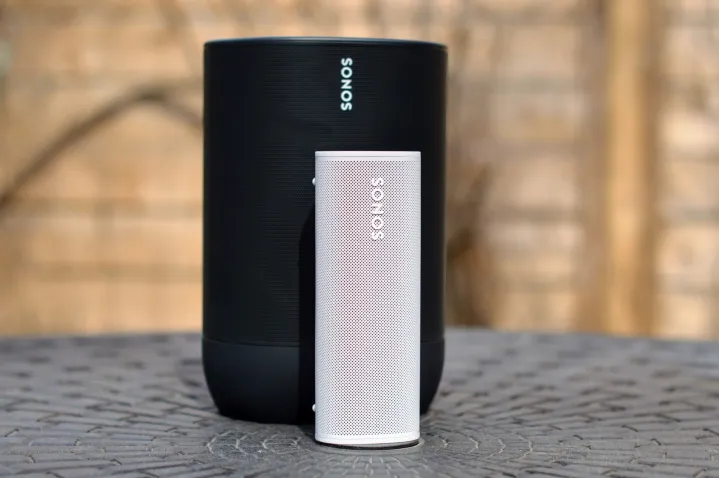
Indeed it does. Sonos offers two sizes: the $399 Move is the company’s larger model. It’s voice-enabled, water- and dust-resistant to the IP56 standard, comes with its own charging station, and has an 11-hour playtime.
The smaller — and newest — portable speaker is the Roam, which has a voice-enabled version ($179) and a non-voice version (Roam SL, $159). Both are dust- and waterproof (IP67 standard, meaning you can submerge them in a meter of water for 30 minutes); they’re both good for 10 hours of play before needing to be recharged.
All three of these speakers work as part of the home system outlined above, meaning you can locate them in any room in your house — they’ll work over your wireless network like all the other Sonos products you own. They also both work over Bluetooth, which means you can take them camping or to your friend’s house and play the music on your phone through them.
When in Bluetooth mode, you won’t be able to use the Sonos app, and you won’t be able to use Google Assistant or Alexa, but Sonos Voice Control will still work for basic playback functions.
What is ‘Works with Sonos’?
Sonos has developed the “Works with Sonos” badge to help its customers identify products that are designed to work seamlessly with their components. Some, like home automation solutions from Crestron and Ikea, can take control of Sonos speakers and components, while other products, like Victrola’s Stream turntable, embed Sonos functionality so that you don’t have to buy additional components. The Stream acts as its own line-in option within the Sonos app. Normally if you wanted to connect a turntable to your Sonos system, it would require a middleman component like a Sonos Port with its own line-in.
How to use Sonos
Setting up a Sonos system is super easy. If you have an existing Wi-Fi router at home, you can add up to 32 Sonos speakers or components, one by one, using the Sonos app.
Once you’ve plugged your first Sonos product into a power outlet, the app will automatically find it and prompt you through the creation of your initial system, including a connection to your Wi-Fi network.
You’ll be asked what room the component is in (with the option to customize the name), and when that component is a Sonos wireless speaker, you’ll be given the option to tune your room with Trueplay, which uses your iPhone’s microphone to assess the audio environment in which your speaker is located and adjust the speaker’s equalizer accordingly. Sonos’ newest speakers, the Era 100 and 300 can also be tuned using their onboard mics, making them the first non-portable Sonos products that give Android users the benefit of Trueplay.
In some cases, home Wi-Fi networks are too congested to let Sonos work effectively. In this case, wiring a single Sonos product into your modem/router lets Sonos establish its own proprietary Wi-Fi network called SonosNet, which can often help with reliability.
Don’t want to have a speaker or other audio component tethered to your modem? Sonos sells a $99 accessory called a Boost, that will take care of establishing SonosNet. Simply plug the Boost into your modem and then place your Sonos audio components anywhere you like.
Once your components are set up and running, you only need to add music sources to start listening.
Sonos can accommodate up to 32 different components on a single system, so you could have Sonos speakers or other components in the living room, kitchen, kids’ bedrooms, master bedroom, back patio, and so on. You can have multiple speakers in one room, and if any two of those speakers are identical (e.g. two Sonos Ones or two Symfonisk Table Lamp Speakers), you can set them up as stereo pairs. It’s up to you.
The components show up individually in the app, by selecting the System tab (which looks like a stylized LED volume meter). Sonos allows you to easily rename them too, so you can identify them by room, speaker, color, or by personal nickname.
You can direct each of your speakers to play a separate song, playlist, or station as you wish. Perhaps your spouse wants to listen to 80s New Wave on the back deck, while you want to listen to today’s alternative rock in the living room. Meanwhile, your kids can keep listening to Taylor Swift in their bedrooms.
But with a few clicks, you can combine any number of speakers together to play a single source, so, for example, you could play Baroque Classics in the living room, dining room, kitchen, and laundry room and it will do so without lag or delay — you can walk from each of those rooms to the other and the same music will just be there, flowing normally.
All of this is independent of the speakers you choose to omit from this grouping, so your spouse can still happily listen to 80s New Wave on the back deck without interruption. There’s also a Play Everywhere option that will direct the music of your choice to play through all of your Sonos components.
Another handy aspect of the Sonos system is that control and playback are independent of each other. In other words, you can think of the Sonos app as a remote control for Sonos components, and everyone in your house can have that remote on their own devices.
If you start an Apple Music stream on your kitchen Sonos One, you can quit the Sonos app, or even leave the house with your phone, and the music will continue until the playlist comes to an end, or someone else in your home takes control using their Sonos app.
The only downside to this arrangement is that there are currently no user profiles within the Sonos system. So if you install the Sonos app on your daughter’s phone, she’ll have just as much control over all of the Sonos components in your home as you do.
What streaming services are on Sonos?
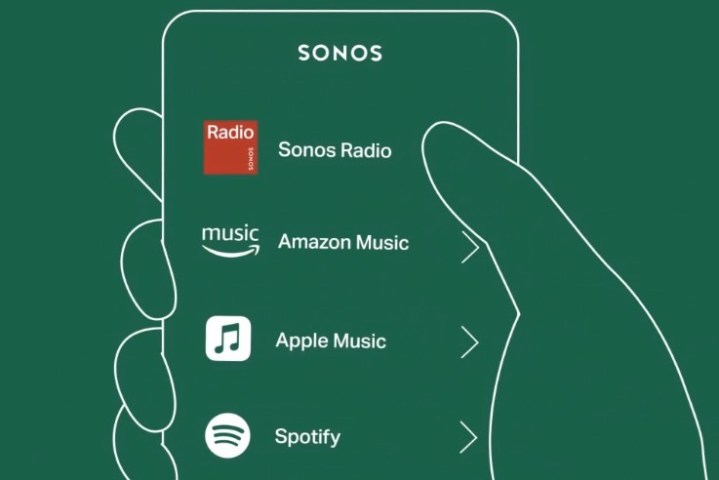
Sonos offers the ability to play music from a wide range of sources, including:
Your existing digital music collection
If you have a collection of digital music located on a PC, network-attached storage (NAS) drive, or an Android mobile device (for iOS users, see our section on AirPlay 2, below), Sonos can play it, along with any playlists you may have created. The software can also scan and index your iTunes library if that’s how you’ve chosen to organize your music. Supported audio formats include MP3, MP4, M4A, WMA, AAC and HE-AAC, OGG, FLAC, ALAC, AIFF, and WAV.
Connected sound sources
Sonos also works with external analog and digital audio equipment if you want. This can include a turntable, CD payer, or tape deck, but also your TV, through an optical or HDMI ARC/eARC connection. You’ll need specific Sonos components to make this work (see the How do I get Sonos to work with my existing audio gear? section, above).
Apple Music, Spotify, and other streaming music services
Sonos also plays nicely with streaming music services: Spotify, Apple Music, YouTube Music, TuneIn, Tidal, Amazon Music, Soundcloud, Audible and many others are also readily available through the Add Music Services option in the Services and Voice tab in the app settings. In fact, Sonos supports more streaming services than any other multi-room music system. It also offers its own streaming music service called Sonos Radio — in both free and paid tiers — as a homegrown alternative.
What is Sonos Radio?
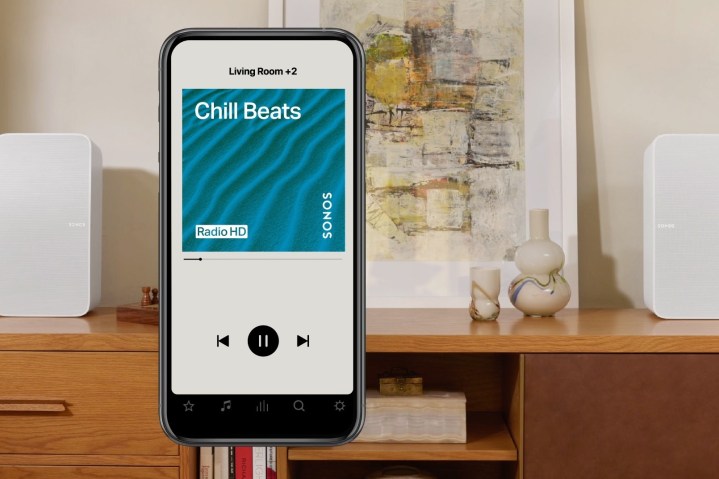
Sonos Radio is a streaming service of curated playlists and radio stations. The free version, simply called Sonos Radio, comes preinstalled in the Sonos app. A paid version called Sonos Radio HD is also available for $8 per month. In both versions, music is primarily organized into genres (Rock, Country, Jazz, Classical, etc.), with multiple stations living within each genre; for example, in the Rock genre, you can choose between stations/playlists for Early Classic Rock, Soft/Yacht Rock, Glam Metal & Ballads, Grunge, Punk Rock, and so on. Other Sonos Radio stations/playlists are categorized by celebrity guest curators, such as Thom Yorke, Dolly Parton, Eryka Badu, and so on. The service also gives you one-touch access to hundreds of local and global music, talk, sports, and news radio stations: News Talk 98.9 ‘Roar of Memphis’ is right there for you if you wish.
If you opt for Sonos Radio HD, the Sonos-created playlists and stations go from a very lossy 128kbps to 16-bit/44.1 kHz lossless, CD-quality audio. It also eliminates the ads and adds the ability to skip songs on station playlists (and immediately replay your faves). You also get more radio stations: 60,000 in total.
Unlike almost any other streaming service, both versions of Sonos Radio only work on a Sonos system using the Sonos app – there’s no standalone app for Sonos Radio available to either iOS or Android users.
Does Sonos have AirPlay?
You may be wondering why you’d want to buy Sonos products when there are now a wide variety of speakers that support Apple AirPlay 2 and Google Chromecast, not to mention the countless ones that have Bluetooth. Here’s how these four technologies compare.
Both AirPlay 2 and Chromecast use Wi-Fi to create a wireless audio link between a phone or computer and a compatible speaker, soundbar, or home audio system. They both support multiroom playback, via Apple and Google’s respective Home apps.
Chromecast is closer to Sonos in that once you initiate a playback session on a Chromecast-enabled speaker, you don’t need to keep your music app open on your phone — the speaker establishes its own connection to the content. But, for Chromecast to work, both your speaker and your audio app need to be Chromecast-enabled.
AirPlay 2, on the other hand, is a peer-to-peer connection. You can stream any audio from your Apple device to a compatible speaker using AirPlay, but if you close that audio app on your phone while in the midst of an AirPlay session, the audio will stop.
But the biggest difference between Sonos and AirPlay/Chromecast is the way you interact with them. With Chromecast or AirPlay, you pick an audio source on your device — like the Spotify app — and use that to control what you’re hearing. But to control where you hear it, or on how many speakers, you need to use the Google Home or Apple Home app. Want to change what you’re listening to? You’ll need to open a new app, like TuneIn or Amazon Music, and go and find your new song, artist, etc.
Does Sonos have Bluetooth?

The core Sonos system is built on Wi-Fi. As a wireless technology, Wi-Fi has several key strengths: It has a lot of bandwidth, so you can stream even the highest resolution, lossless audio without any bottlenecks. It’s literally networked — all Wi-Fi devices on the same network can speak to each other, passing data back and forth, and that allows for incredible control within the Sonos app. Being able to add, remove, and group Sonos components relies on Wi-Fi.
It also enables mesh networking when you’ve set up your Sonos system using SonosNet — each Sonos device can act as a wireless bridge to the next-nearest Sonos device, letting you spread out your speakers and components much farther than you could using a regular Wi-Fi router. Because Wi-Fi doesn’t use the same part of your phone’s audio system as Bluetooth, Wi-Fi music doesn’t have to stop when your phone rings or you want to place a call.
But Wi-Fi also has limitations. It’s very power-hungry, so Wi-Fi devices are usually plugged into power continuously instead of relying on batteries that can die. Wi-Fi (with a few rare exceptions) needs the presence of a Wi-Fi router, or in the case of Sonos, a component that’s wired to your modem/router, so it simply doesn’t work when you’re away from home.
Bluetooth, on the other hand, is a wireless technology that’s ideal in these situations. It takes far less power to operate, and it works device-to-device, from a phone or tablet directly to a Bluetooth speaker — no network required. But the absence of a network can make it hard to manage multiple Bluetooth speakers. Companies that have managed to do so typically rely on a repeater-style solution, where you can daisy-chain multiple Bluetooth speakers, but there’s no individual control, and all of the chained speakers must play the same audio.
Bluetooth has also been bandwidth-limited, traditionally. This is changing, but the vast majority of Bluetooth devices can only play highly compressed music streams. Where Bluetooth is able to achieve wireless, hi-res audio, it requires specific, shared Bluetooth codecs on both the source device (like a phone) and the sink device (the speaker).
For years, Sonos did not make any products that used Bluetooth, but recently it has changed its tune. In addition to the portable Sonos Move and the smaller Sonos Roam, the new Era 100 and 300 speakers also support Bluetooth. The only caveat is that when these speakers are in Bluetooth mode, you can’t use the Sonos app to control them.
Are there any Sonos alternatives?

Wireless home audio systems are popular, and so there are a number of companies competing with Sonos. Bose has its own ecosystem of whole-home wireless speakers, which are compatible with Wi-Fi, Bluetooth, Chromecast, and AirPlay. You control it through the Bose Music app, but the software isn’t as intuitive as Sonos. There’s no universal search and Bose does not currently support Apple Music within its own app. Bose also doesn’t handle multiple sources of music across multiple rooms and/or speakers as effortlessly as Sonos.
Google Nest Audio is another alternative and works better than Bose across multiple rooms and products, but it only has two models of speakers to choose from. If you have only one room or a bachelor flat — and no immediate plans to expand — the Google Nest Audio might suffice.
The Apple HomePod Gen 2 is the Apple ecosystem’s wireless, multiroom speaker. You can manage multiple HomePods (and HomePod minis) from the Apple Home app. Like the Bose system, it’s not as powerful for managing multiple sources of music, and Apple’s emphasis on using Siri for most functions (and its lack of Bluetooth) keeps it strictly for Apple fans.
For larger and/or multiple rooms, Denon’s Home family of wireless speakers offers more robust audio credentials, but its HEOS app is tricky to navigate, and it offers only limited features compared to Sonos; Denon speakers tend to be larger and a bit more powerful but are also more expensive than comparable Sonos speakers.
Perhaps the closest competitor to Sonos is Bluesound. The Canada-based company has a lineup of speakers and components that mirror almost all of Sonos’ offerings. Even the Bluesound app, powered by BluOS, is remarkably similar to Sonos.
Finally, there’s Wiim. The company only makes two products, the Wiim Mini and Wiim Pro, which are both roughly equivalent to the Sonos Port, but they’re incredibly affordable. The Wiim software is so close to Sonos, we’d be surprised if these two companies don’t end up in court one day.
Editors’ Recommendations
Source link




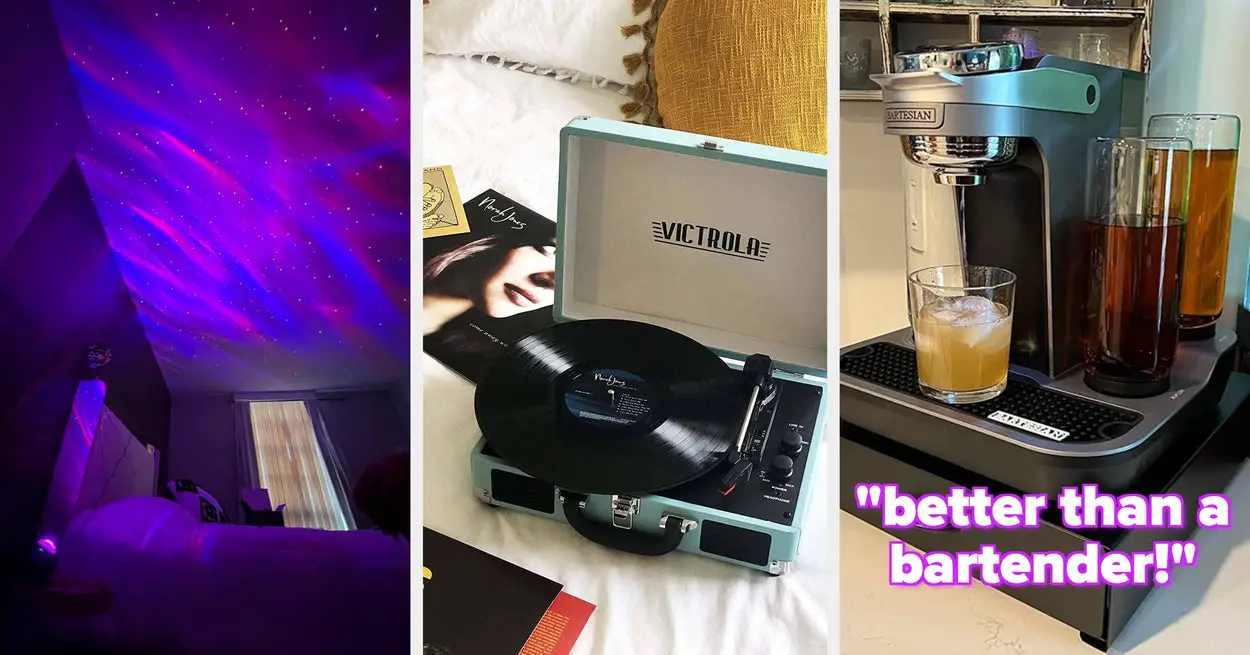




Leave a Reply